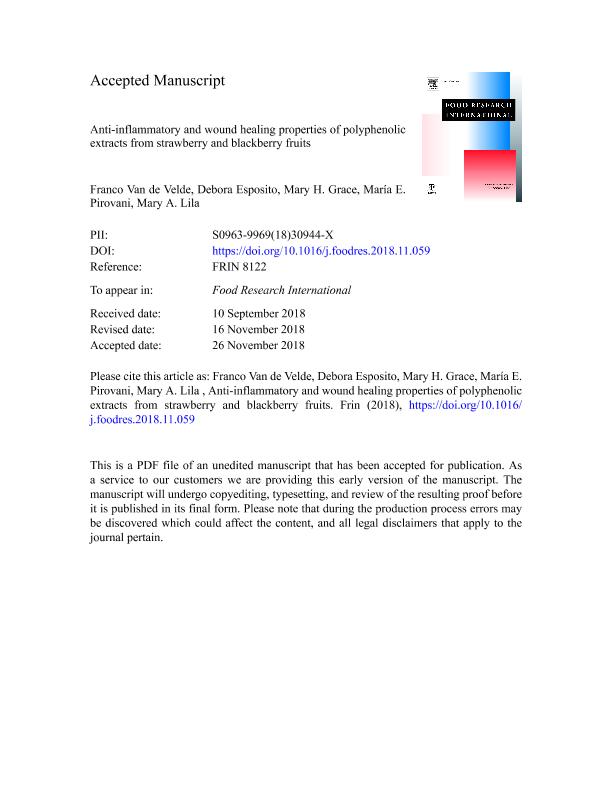Mostrar el registro sencillo del ítem
dc.contributor.author
Van de Velde, Franco

dc.contributor.author
Esposito, Debora
dc.contributor.author
Grace, Mary H.
dc.contributor.author
Pirovani, Maria Elida

dc.contributor.author
Lila, Mary Ann

dc.date.available
2022-02-09T20:04:43Z
dc.date.issued
2019-07
dc.identifier.citation
Van de Velde, Franco; Esposito, Debora; Grace, Mary H.; Pirovani, Maria Elida; Lila, Mary Ann; Anti-inflammatory and wound healing properties of polyphenolic extracts from strawberry and blackberry fruits; Elsevier Science; Food Research International; 121; 7-2019; 453-462
dc.identifier.issn
0963-9969
dc.identifier.uri
http://hdl.handle.net/11336/151715
dc.description.abstract
The polyphenolic profiles by HPLC-TOF-MS of strawberry ‘San Andreas’ and blackberry ‘Black Satin’ crude extracts (CE) were analyzed. Anthocyanin-enriched fractions (AEFs) and proanthocyanidin-enriched fractions (PEFs) were prepared, and all samples were probed for in vitro anti-inflammatory and wound healing effects in a LPS-stimulated RAW 264.7 macrophage model and in a skin fibroblast migration and proliferation assay, respectively. Blackberry samples exhibited higher ROS reduction than strawberry's (up to 50% ROS suppression). Berries CEs exhibited 20% inhibition in Cox-2 gene expression, while AEFs and PEFs were inactive at the same concentration. Strawberry AEF and PEF were more active against IL-1β and IL-6 gene expressions than the similar fractions from blackberry, where PEF was more active than AEF (75% suppression by strawberry PEF). Moreover, berry PEFs were the active polyphenol fraction against iNOS gene expression (50% and 65% gen suppression by strawberry and blackberry PEF, respectively), mirroring results of NO synthesis suppression. The cell migration potential of berry polyphenolics was associated with anthocyanins. AEFs showed fibroblast migration around 50% of that registered for the positive control. Results obtained in this work highlight the anti-inflammatory properties of berry polyphenolics, especially due to proanthocyanidins. Moreover, promising results were obtained about the effects of berry anthocyanins on wound healing.
dc.format
application/pdf
dc.language.iso
eng
dc.publisher
Elsevier Science

dc.rights
info:eu-repo/semantics/openAccess
dc.rights.uri
https://creativecommons.org/licenses/by-nc-nd/2.5/ar/
dc.subject
ANTHOCYANINS
dc.subject
CYCLOOXYGENASE-2
dc.subject
FRAGARIA ANANASSA
dc.subject
INTERLEUKIN-6
dc.subject
PROANTHOCYANIDINS
dc.subject
RUBUS FRUTICOSUS
dc.subject
SKIN CELL MIGRATION
dc.subject.classification
Otras Ciencias de la Salud

dc.subject.classification
Ciencias de la Salud

dc.subject.classification
CIENCIAS MÉDICAS Y DE LA SALUD

dc.title
Anti-inflammatory and wound healing properties of polyphenolic extracts from strawberry and blackberry fruits
dc.type
info:eu-repo/semantics/article
dc.type
info:ar-repo/semantics/artículo
dc.type
info:eu-repo/semantics/publishedVersion
dc.date.updated
2020-11-27T18:45:36Z
dc.journal.volume
121
dc.journal.pagination
453-462
dc.journal.pais
Países Bajos

dc.journal.ciudad
Amsterdam
dc.description.fil
Fil: Van de Velde, Franco. Consejo Nacional de Investigaciones Científicas y Técnicas. Centro Científico Tecnológico Conicet - Santa Fe; Argentina. Universidad Nacional del Litoral. Facultad de Ingeniería Química; Argentina
dc.description.fil
Fil: Esposito, Debora. North Carolina State University; Estados Unidos
dc.description.fil
Fil: Grace, Mary H.. North Carolina State University; Estados Unidos
dc.description.fil
Fil: Pirovani, Maria Elida. Universidad Nacional del Litoral. Facultad de Ingeniería Química; Argentina
dc.description.fil
Fil: Lila, Mary Ann. North Carolina State University; Estados Unidos
dc.journal.title
Food Research International

dc.relation.alternativeid
info:eu-repo/semantics/altIdentifier/url/https://www.sciencedirect.com/science/article/pii/S096399691830944X?via%3Dihub
dc.relation.alternativeid
info:eu-repo/semantics/altIdentifier/doi/http://dx.doi.org/10.1016/j.foodres.2018.11.059
Archivos asociados
